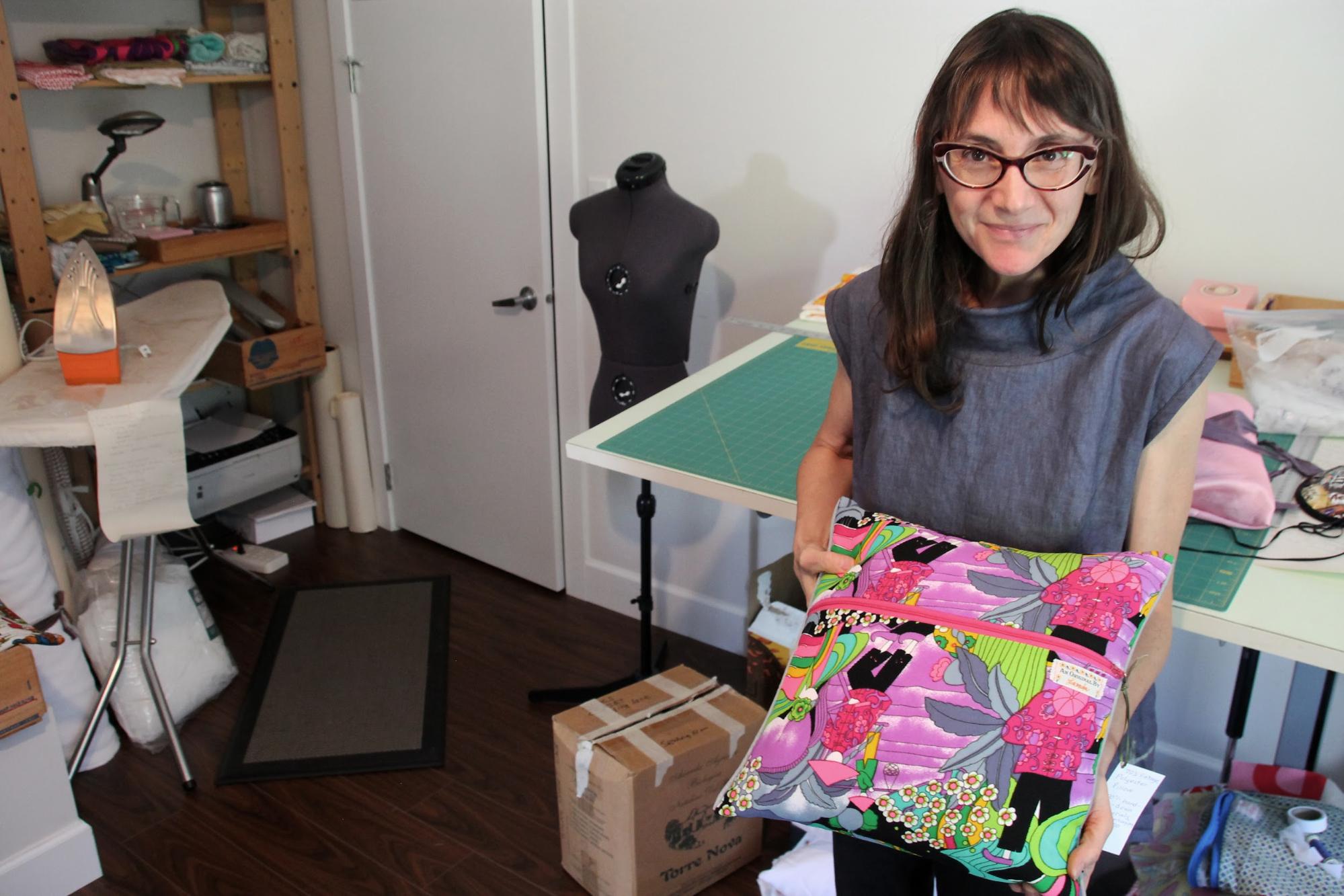Leah Price was in the middle of a household waste audit the week she started discussing separation with her husband.
The audit involved saving and sorting household garbage over a two-week period, then itemizing and weighing each piece of garbage and listing all the contents.
She was shocked.
“That garbage did not look like my garbage at all,” she recalls. “It could have been a completely different family. We had something like four pizza boxes and Chinese take-out, 7-Eleven coffee cups... It really occurred to me what a story our waste tells about us.”
Price is a 51-year-old artist, accomplished sewer, trained teacher, certified master recycler and mother of two children with special needs. She is working on turning her enmity for waste and skills as a seamstress into a Vancouver-based business that also helps the environment.
Three months after that first waste audit, Price was in the process of separation and decided to catalogue the family’s garbage for a second time.
The garbage told a different story, and sparked a different reaction from Price. There were sentimental connections to the material – leftovers from a last New Year’s, a last Valentine’s Day, even a last Costco run.
Price channelled her responses into art.
“When I have some big question in mind I need to keep my hands busy,” she said. “I need to make something and I am always making it out of garbage.”
Price’s “big question” turned into the art show Divorce: a Waste Audit.
Price made more than 30 pieces of art from the remains of her waste audit, exploring the end of her marriage and of 18 years of life in her West 10th Avenue home. Her soon-to-be-vacated house became a gallery for three days. Admittance was by donation, with proceeds going to the Foundation for Prader-Willi Research.
Price’s fascination with art and waste intersects with her passion for sewing in her new business.
Price offers classes in “zero waste sewing” from her new home and hopes to start selling her own work at a volunteer-run non-profit organization called Our Social Fabric (OSF).
Our Social Fabric’s volunteers take donations of sewing machines and materials from industry, designers and individuals. It has a monthly sale, with low prices to ensure the material is accessible to anyone.
The group hopes to start selling members’ work at their new storefront at 340-1275 Venables St. in Vancouver.
The close-knit, vibrant community of sewers and artists sometimes takes inspiration from the challenges in using the donated material – like the attempt to make something out of disposable diaper fabric from a failed medical invention project at BCIT. Price completed an avant-garde, absorbent coat out of the material.
As a volunteer, Price is allowed to take material home, although she only claims material that doesn’t sell.
Price takes a special interest in donations from estates, when family members pass on fabrics or partially-finished clothing from a relative who has died.
The fabrics bring a connection with the lives of others, she said. Forensic sewing, she calls it.
“This person had a lot of time to sew,” she says, fingering donated fabric. “There is a lot of colour and a lot of different fabrics in there. There is some sort of Mary Tyler Moore type outfits there. And some Twiggy dresses there. So we are talking early ‘60s to the early ‘70s.”
“But why did she save it?,” Price wonders.
Some fabrics give Price a glimpse into our cultural history. A bolt of fabric with stick characters of a person in a top hat being pulled in a rickshaw by a person in an Asian hat with the word Peace repeated, or cloth displaying stereotypical cartoon likenesses of Indigenous people are remnants of another time.
“Who designed it in the first place?,” Price asks. “And what were they thinking?”
Price can gauge the sewers’ style from their scraps, see the skill in their stitches and sense frustration in the mistakes that show up in the half-finished projects that OSF receives.
People who donate fabric are happy to know it has a home and won’t be dumped in a landfill, she says. “I will hold on to something for a long, long time looking for somebody who might want to use it,” she says.
“I kind of think of myself as the conduit through which stuff flows to where it should go. I really love it when I can find a match between an item and someone who is happy to have that item.”
Price’s style and skill have developed over a lifetime. She started sewing when she was eight in Brownies and later trained with a master couturier. Some of her intricate projects take more than a year to complete and include old, almost lost techniques.
She hopes to sell some of the projects, and had a booth at the Westside Community Food Market over the summer.
Others are personal, like the underwear shirt.
“This was my husband's underwear,” she said. “This was, a year ago, Valentine's Day. He threw out four pair of underpants. And I was joking, right, like don't throw it away I want to make something out of it.”
But by the end of the day, the shirt was done.
Nothing goes to waste – Price even reuses clothing tags, sewing her own name on top of the original to create a lineage for the garment.
Price completed the eight-week Master Recycler last year. It was the impetus for her waste audits and encourages people to look at their consumption and start thinking about the benefits of a circular economy in which goods are recycled, not discarded.
Taking a closer look at our waste and the stories behind it can help change people’s habits, she says.
“I mean, there is so much material in the world, I don’t just mean textiles, we have so much stuff,” she said. "I really think we’ve got enough, we don’t need to make more.”
“We should use up what we’ve got – in some imaginative way if necessary.” ![]()
















Tyee Commenting Guidelines
Comments that violate guidelines risk being deleted, and violations may result in a temporary or permanent user ban. Maintain the spirit of good conversation to stay in the discussion.
*Please note The Tyee is not a forum for spreading misinformation about COVID-19, denying its existence or minimizing its risk to public health.
Do:
Do not: